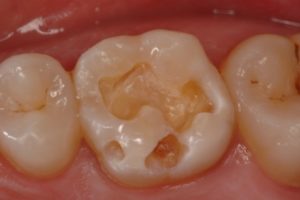
ODONTOLOGÍA CONSERVADORA
Conservative Dentistry
Conservative dentistry is the most biocompatible and minimally invasive dental specialty, developed to restore the structural part of the tooth that has been damaged or lost (due to trauma, wear, or cavities), through the use of the most advanced metal-free materials, ensuring an aesthetic, biomimetic, and functional result.
Our goal at Clínica Dental Murtra is to offer personalized check-up, hygiene, and maintenance plans so that, in a preventive way, we aim to reduce dental deterioration and diagnose all primary issues related to the mouth, teeth, and other associated structures (such as the temporomandibular joint).
What is tooth decay?
Tooth decay is a dental infection caused by the bacteria that reside in dental plaque, which are responsible for the acid attack that creates cavities in our teeth.
At first, these cavities/tooth decay do not present any symptoms, but as they get closer to the nerve, sensitivity to cold may appear, followed by sensitivity to heat, and eventually it develops into persistent pain, at which point a root canal treatment will be necessary to eliminate the bacteria that have already settled in the root canals.
Frequent Treatments
FISSURE AND PIT SEALING
Cuando los surcos naturales de los dientes tienen una anatomía muy profunda y se observa gran acumulación de placa, una manera de prevenir posibles futuras caries es, tras su limpieza, proceder a su sellado con material resinoso fluido.
FILLING OR RESTORATION
If the cavity has not affected the pulp (the nerve), the most biocompatible and minimally invasive treatment of choice is a filling or restoration (terms used depending on the size of the area to be treated).
After removing all decayed or damaged tissue, the cavity is prepared and disinfected, and finally the functional anatomy of the tooth is restored using composite—a highly moldable resin capable of imitating the natural color of the remaining tooth—thus completing the filling or restoration in a conservative, aesthetic, and functional way.



INLAYS, ONLAYS, OVERLAYS
When the loss of dental tissue is too extensive for a filling to withstand chewing function, the most conservative way to restore what has been lost is a ceramic or reinforced composite inlay. If the damage is more extensive, the final alternative is a dental crown.
After preparing the tooth, giving it a specific shape for the inlay (if it only fills the internal part), onlay (if it covers one or more cusps), or overlay (if it covers all its cusps), an impression (mold) is taken, and at the next visit, it is cemented so that the tooth regains its anatomy, aesthetics, and chewing function/strength in a more predictable and long-lasting way than a filling.
CROWN, CAP OR BRIDGE
When the amount of lost tooth structure is too great and there are no walls to support our restorations, the treatment of choice is a crown/cap (if it is a single tooth) or a bridge (if it involves more than one tooth).
In order to place the crown, the lost part of the tooth must first be rebuilt (as if it were a filling – link to filling section – ), and then its perimeter is reduced so that, once the crown is placed in the mouth, it occupies exactly the same volume as the original tooth, while restoring both its aesthetics and chewing function.
Whether it is a single tooth (crown) or multiple teeth (bridge), the procedure is the same: filing and reducing the tooth to create the necessary space for the materials that make up the fixed prosthesis. This sometimes necessitates performing a root canal (link to endo), since by reducing the height, the nerve may be exposed.
Currently, there are different types of materials with which crowns can be made; from the more traditional (metal-ceramic) to the more aesthetic (lithium disilicate or zirconia). Everything will depend on the tooth that needs to be restored.
- Classic technique that has been used for over 100 years, with extensive clinical experience.
- It allows restoring what has been lost and modifying shape, aligning, leveling, and correcting rotations (instead of correcting with orthodontics).
- It prevents neighboring teeth from tilting, maintains contact points, and preserves the bite plane, proper occlusion, and a healthy temporomandibular joint.
- High aesthetic quality.
- A fixed solution that allows us to smile, speak, and chew without the need for adhesives, etc.…
YOUR DOCTORS
Dra. Cristina Murtra
Degree in Dentistry, UIC 2008
PhD in Health Sciences, UIC 2014
Postgraduate in Dental Aesthetics, UB 2016
Medical Director specialized in: Aesthetics, Oral Rehabilitation, and Occlusion / TMJ
Being aware that there is nothing better than giving and receiving smiles, I work hard every day gathering and studying proportions, patterns, and measurements in order to restore them when they have been lost.



